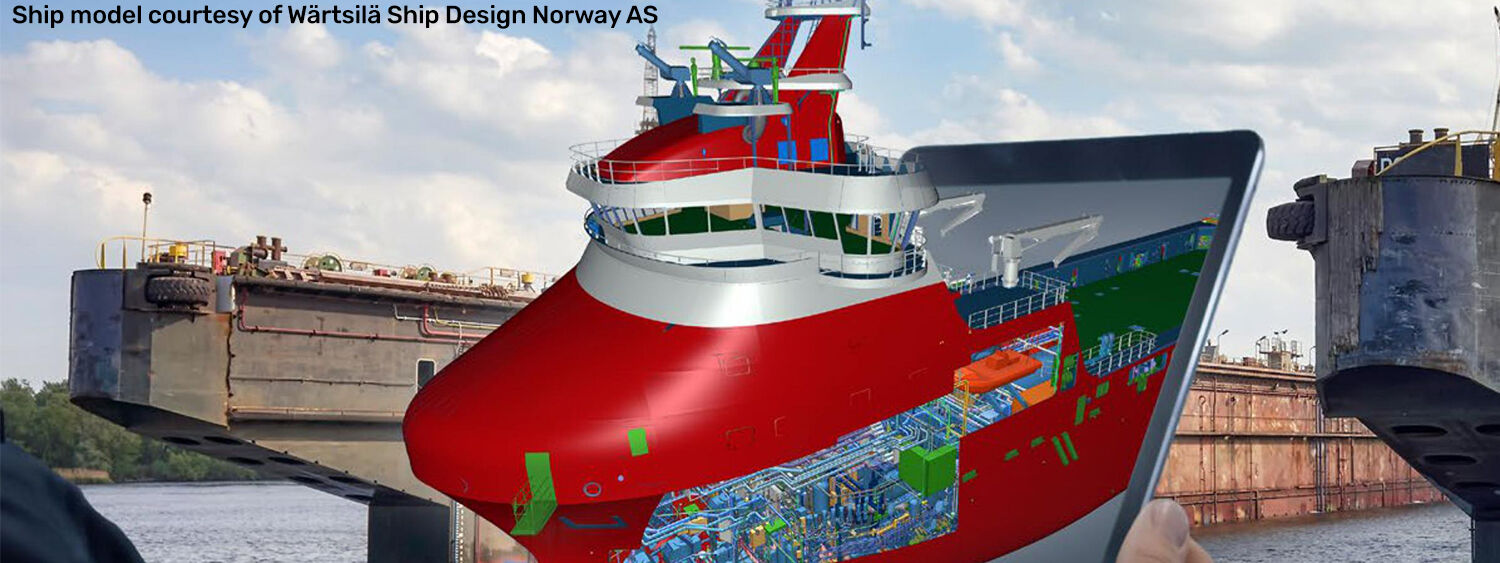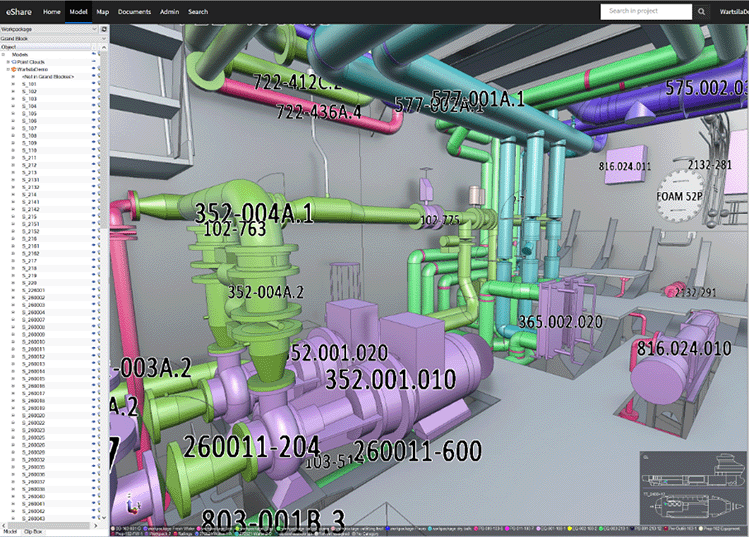Read more and download the complete white paper.

Information management in shipbuilding projects – Information flow from 3D design to production data
Written by Ludmila Seppälä
Posted on September 30, 2022
This article is a shortened version of a paper that was presented at ICCAS 2022.
The complexity of modern shipbuilding, along with changes in the business environment and the growing capabilities of digital solutions, challenges work processes and enables efficiency gains by eliminating gaps in information flows. This article discusses the changes in modern ship design and production and the interconnections between these two phases of the shipbuilding lifecycle from an information management point of view. It offers several examples of shipyard practices and outlines the development direction for digital transformation in this area.
3D design in shipbuilding
Modern shipbuilding CAD software allows users to enrich the 3D data with production information already in the early stages of design. A safety net of settings and predefined values surround the designer’s actions to assist with the regulations of the classification society and to ensure the readiness of the design data for production. There are thousands of automatic functions that assist ship designers in creating 3D data and setting the stage for production data output.
Besides the primary functional considerations, the main trends shaping modern ship design via digitalization and sustainability goals include the following:
- Increased demand for flexibility and speed in the early design stages to evaluate design variants and estimate the economic feasibility of different powering options
- Automation of routine design tasks and a high level of embedded rules and settings, based on requirements or best practices, to assist the designer
- Interoperability of data formats to enhance concurrent execution of calculations, design, simulation, and production output
Modern shipbuilding production
The primary goal of the shipbuilding process is to manufacture the vessel according to the defined specifications and deliver it on time and without defects. Therefore, the engineering and design process must provide the required production data and not only focus on fulfilling design and functional goals. Historically, technical departments were concerned primarily with the vessel function, and production information was developed later by draftsmen in production departments, such as the steel or piping production department.
This process changed in modern shipbuilding. The impact of productivity requirements, economic returns, and IT system development has changed the shipbuilding production landscape as follows:
- Production flow became the basis for the shipyard’s layout and served as the primary productivity improvement area for modernization in the last decade.
- Production strategy, dictated by economic reasoning, disconnected the design and production processes. It may be a “design from stock” or modular engineering process when the design is created before the production site is selected and production requirements are known. It can be an “offshoring” strategy for using a remote construction site for steel construction due to cheaper labor costs and lower requirements for quality while keeping outfitting production at the yard. Initiatives, such as shared production facilities, require specific production data output to support high volumes of production that will be assembled in micropanels and later used in the construction of different projects and shipyards.
- Machinery and automation equipment of production lines – advanced robotics and computational tool applications leaped forward in the last decade resulting in more connected manufacturing and automated assembly lines in shipyard production processes.
Due to these changes, production needs for data cannot be satisfied with a set of 2D documents and material take-offs from the design stage. In most cases, the required data is adaptable output for the design stage, with a high degree of flexibility in the definition of the work breakdown structure and data presentation and the ability to take the required machinery output into account. Besides design data, production needs consolidation with planning and project management to facilitate the whole process.
Examples of data flow gap mitigation between engineering and production
The examples below originate from shipyards’ experiences in optimizing their work processes by implementing modern shipbuilding technology, such as Cadmatic ship design applications and its information management platform. Addressing and improving information and data flows between existing systems provides tangible gains in productivity and a gradual increase in digitalization gains.
Placing data in the context of production tasks with color coding
Access to information does not guarantee that it can be used in time. For example, work package information may be available in a manufacturing system, but it is disconnected from the 3D model and provides only textual status updates to production teams. The ability to visualize this data in 3D and provide access to any other data in the required format, such as on a tablet or via a VR/AR set, is a game-changer for the production process due to the ability to visualize the data in digital format and thus enhance interactions. It also opens the gate to industrial metaverse applications and provides for the use of 3D digital data residing in physical environments in the production process.
An example from ship production practice concerns the weight of equipment information for installation teams. For on-site teams, it is critical to have information about the weight of equipment scheduled for installation before planning activities. It can be solved by merging available data from several sources and visualizing it for planning on-site activities: the ERP system containing the weight information after the procurement and the 3D engineering model. The design of the information flow included access to the ERP data, the selection of equipment for which it is required (with weight over 25kg), and comparison criteria for engineering defined weight and data from the ERP system. Results for the planning and installation included a pre-set visualization style in the information management platform with one-click colored 3D models according to the weight data. This way, on-site work can be planned to take access to heavy lifting machines and cranes into account and avoid situations where installation teams must make unplanned hull cuts or wait for heavy equipment lifting.

Planning of installation packages
A typical modern shipbuilding project includes 500-1000 piping work packages for installation. Manufacturing and installation planning for the production based exclusively on engineering data may result in delays and disruptions due to the lack of information about deliveries from pipe shops or suppliers. Including the data from ERP (or another type of system) enables data merging: engineering and work breakdown, and delivery progress from workshops or subcontractors and placing it in the context of the work process.
This example represents a case where consolidating data from engineering and installation planning using innovative technology can significantly save time. It is a laborious task if there is only one project, while if a shipyard has several subcontractors delivering pipe packages and tens of simultaneous projects – it becomes essential for production planning and control.

Communication between design and production in the shipbuilding network
Providing information “on-demand” and in context reduces the number of paper drawings and creates an interactive digital environment. Having “single-source-of-truth” data can significantly increase the quality of decisions and reduce the time spent searching and verifying information. At the same time, providing the context for production execution can increase production quality and at least partially address the lack of skills or understanding of the overall process by production teams. Adding a link between the design model and nesting status provides a solution to track the hull building process accurately. It allows designers to instantly see what parts have been cut and welded. The progress of building and inspection is also visible, which reduces the number of uncertainties and questions.

Information flow: benefits of digitalization and flexibility for work processes
Digitalization is not just the use of digital technologies. It is a way of transforming work processes and providing new possibilities – the vision of seamless information flow and drawingless production is already becoming a reality in modern shipbuilding. Besides robust functionality to support design and production phases, intelligent technology should support data integration with existing systems and allow companies to engage in a step-by-step digitalization process. Addressing the gaps in information flows grounds the development of digital solutions around shipbuilders’ needs. This approach embraces Industry 4.0 concepts and goes toward the Industry 5.0 concept of developing IT solutions – including sustainable goals and skills in the equation of digitalization. The digital solutions are thus not only developed in functionality according to the possibilities of data handling by IT systems, but follow and challenge the work patterns and serve the goals of the overall shipbuilding process.
